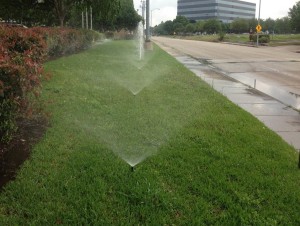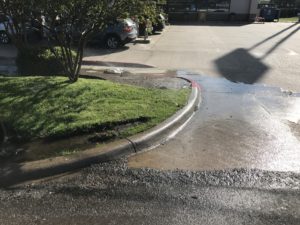What is stormwater runoff? Stormwater runoff is rain fall that runs on the ground or impervious surfaces like buildings, roads or parking lots and drains into our waterways. Water flowing over the land picks up an array of contaminants including oil from roadways and chemicals from lawns. This water finds its way into waterways either directly or through storm drains.
The storm drainage system is a series of pipes and ditches designed to move water in a quick and efficient manor away from roadways and parking lots into local waterways, and ultimately Galveston Bay.
Stormwater runoff pollution is often referred to as non-point source pollution, because it does not have a single point of origin. Runoff pollution is the cumulative result of our everyday personal actions and land use policies. There are different kinds of stormwater runoff pollution including pathogens, nutrients, sediment and debris.
Pathogens are disease-causing microorganisms, such as bacteria and viruses, that come from the fecal waste of humans and animals. Exposure to pathogens, either from direct contact with water of through ingest of contaminated shellfish can cause a number of health problems. Pathogens wash off the land from wild animals, pet waste, and farm animals, and can also enter our waterways from improperly functioning septic tanks, leaky sewer lines and boat sanitary disposal systems.
Nutrients are compounds that stimulate plant growth, like nitrogen and phosphorous. Under normal conditions, nutrients are beneficial and necessary but in high concentrations, they can become an environmental threat. Over fertilization of ponds, bays and lakes by nutrients can lead to massive algal blooms, the decay of which can create odors and rob the waters of life-sustaining dissolved oxygen. Nutrients in polluted runoff can come from home lawn care products, agricultural fertilizers, septic systems, and yard and animal waste.
Sediments such as sand, dirt and gravel eroded by runoff usually ends up in stream beds, ponds or shallow coastal areas, where they can alter stream flow and decrease the healthiness of aquatic habitat. Poorly protected construction sites, agricultural fields, roadways and suburban gardens can be major sources of sediment.
Debris or trash is without a doubt the simplest type of pollution to understand. It interferes with enjoyment of our water resources and, in the case of plastic and Styrofoam, can be a health threat to fish, crabs and other aquatic organisms. Typically this debris starts as street litter that is carried by runoff into out waterways.
Here are 12 things YOU can do to combat stormwater runoff pollution:
- Pick up pet waste and deposit it in garbage cans instead of allowing it to wash into waterways
- Take your car to a commercial car ash or wash it in the yard instead of the driveway
- Divert sprinklers to grassy areas instead of impervious surfaces such as driveways and sidewalks
- Use organic lawn care options instead of chemical fertilizers and pesticides
- Don’t pour anything down a storm drain, remember it leads directly into our bayous
- User fertilizers on your lawn only when necessary and always apply according to package instructions
- Sweep sidewalks and driveways instead of hosing them down
- Use native plants in your garden – they require less watering and maintenance
- Participate in a storm drain labeling program in your town to let others know that stormwater drains into Galveston Bay
- Pick up trash and dispose of it properly
- Harvest rainwater for irrigation


